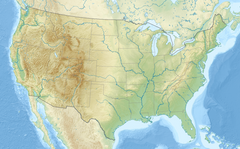Dyer Observatory
 Dyer Observatory logo | |||||||||||||||||||||||||||
| Alternative names | Arthur J. Dyer Observatory | ||||||||||||||||||||||||||
|---|---|---|---|---|---|---|---|---|---|---|---|---|---|---|---|---|---|---|---|---|---|---|---|---|---|---|---|
| Organization | Vanderbilt University | ||||||||||||||||||||||||||
| Observatory code | 759 | ||||||||||||||||||||||||||
| Location | Nashville, Tennessee | ||||||||||||||||||||||||||
| Coordinates | 36°03′08″N 86°48′18″W / 36.05222°N 86.80500°W | ||||||||||||||||||||||||||
| Altitude | 345 metres (1,132 ft) | ||||||||||||||||||||||||||
| Established | 1953 | ||||||||||||||||||||||||||
| Website | Dyer Observatory | ||||||||||||||||||||||||||
| Telescopes | |||||||||||||||||||||||||||
| |||||||||||||||||||||||||||
The Dyer Observatory, also known as the Arthur J. Dyer Observatory, is an astronomical observatory owned and operated by Vanderbilt University. Built in 1953, it is located in Nashville, Tennessee, and is the only university facility not located on the main campus in Nashville. The observatory is named after Arthur J. Dyer, who paid for the observatory's 24-foot (7.3 m)-wide dome, and houses a 24-inch (610 mm) reflecting telescope named for astronomer Carl Seyfert. Today, the observatory primarily serves as a teaching tool; its mission is to interest the public in the fields of astronomy, science and engineering.[3] The observatory was listed on the National Register of Historic Places on March 6, 2009.[2][1]
History
Vanderbilt's first observatory was housed on the campus itself. It was equipped with a 6-inch (150 mm) refracting telescope and was the site of E. E. Barnard's earliest astronomical work. Barnard would eventually discover 16 comets and the fifth moon of Jupiter, receive the only honorary degree Vanderbilt has ever awarded, and have the on-campus observatory named in his honor.[4] However, that on-campus observatory would eventually prove insufficient for the university's needs.[5]
When Seyfert joined the university's faculty in 1946, he lobbied for increasing the astronomy department's modest course offerings and for a new observatory.[5] He solicited donations from over 80 Nashville businesses to outfit the new observatory and convinced Dyer, owner of Nashville Bridge Company, to donate the funds for and to install the observatory's dome. When the observatory opened in December 1953, Seyfert was named its director, and, after his death, the 24-inch (610 mm) telescope was named in his honor.[6]
The dome was originally painted aluminium, but this caused problems with observations before midnight while the telescope dome cooled. It was subsequently painted white in 1963, which significantly reduced the temperature of the dome and improved observations.[7]
See also
References
- ^ a b c "Announcements and actions on properties for the National Register of Historic Places, March 13, 2009". New listings. National Park Service. Retrieved March 13, 2009.
- ^ a b Scarlett C. Miles; Brian Beadles; Claudette Stager (December 2008). "National Register of Historic Places Registration: Arthur J. Dyer Observatory" (PDF). National Park Service.
{{cite journal}}: Cite journal requires|journal=(help) (78 pages, including historic photos, blueprints, maps, diagrams and 36 color photos) - ^ "Dyer Observatory Home". Vanderbilt University. Archived from the original on July 29, 2007. Retrieved June 28, 2007.
- ^ Carey, Bill (October 29, 2001). "Astronomer Barnard was among Vanderbilt's first academic superstars". The Vanderbilt Register. Archived from the original on February 11, 2007. Retrieved June 27, 2007.
- ^ a b "Carl Keenan Seyfert (1911-1960)". Students for the Exploration and Development of Space. Retrieved June 28, 2007.
- ^ "Dyer History". Vanderbilt University. Archived from the original on August 28, 2006. Retrieved June 28, 2007.
- ^ Hardie, R. H.; Geilker, C. D. (June 1964). "On Thermal Effects of Observatory Exterior Paint". Publications of the Astronomical Society of the Pacific. 76 (450): 169. Bibcode:1964PASP...76..169H. doi:10.1086/128076.
External links
- Vanderbilt Dyer Observatory homepage
- Vanderbilt Dyer Observatory Clear Sky Clock Forecasts of observing conditions.




